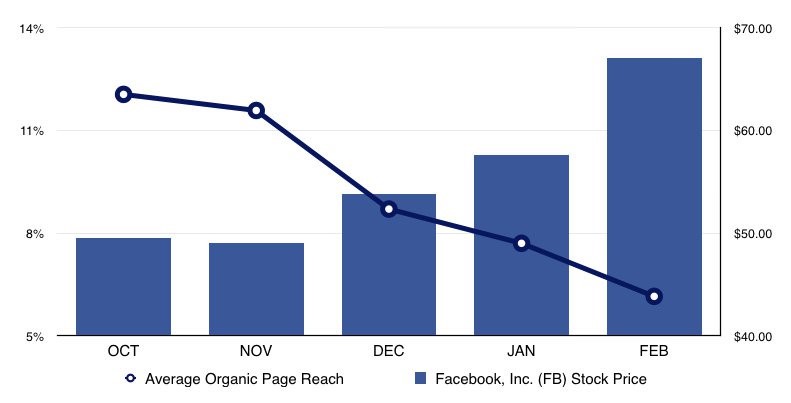Facebook is no longer just “post and forget” — you need to target, analyse and engage

You probably don’t need another person to tell you that ”everyone is on Facebook” and your business should also leverage Facebook. It’s widespread these days.
Well, these people are not lying. Facebook records a user base of about 3 million people in Singapore. On average, Singaporeans spend 2.2 hours daily on this platform. These are staggering numbers from a marketing standpoint.
The problem is that Facebook introduced so many features and changes in their platform in the recent two to three years, its easy to lag behind and misapply outdated strategies that wastes our precious resources as businesses and entrepreneurs. Having worked with companies ranging from startups to MNCs in their advertising efforts. I have identified eight common traps you need to be aware of:
1. Don’t bother posting on Facebook
Are you thinking about what to post on your Facebook page next week? Well, you can probably drop the thought.
This would have been a good move in 2012, when your post can reach as much as 16 per cent of your fanbase. The figure dropped to 6.5 per cent in 2014. Now, it is less than 2 per cent. That’s not all. Only a further 5 per cent or less of this measly 2 per cent is going to pay attention to your post on their newsfeed. That is only about 0.1 per cent of your fanbase. Shocking?
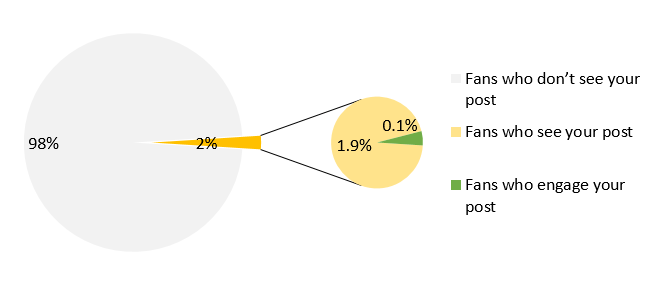
Facebook page organic reach to your fans per post (Note: These are average figures. Your numbers will vary depending on the level of engagement on your page & post.)
It would have account for something if you have a fanbase of say, 10,000. If your Facebook fan count is 300 or less, honestly, the time would be better spent elsewhere. There is absolutely no need to put up posts daily, or even weekly for that matter, as with the case of so many businesses I see. We all love to think that we are very important and everyone is waiting for us to post. Fact? People are so busy with stalking their friends and relatives on Facebook to give us any attention.
On the other hand, you cannot totally ignore Facebook either. People need to know that you are still in business. Strive to at least post once a month, but there is absolutely no need to scratch your head agonizing what to write everyday.
2. Be careful of the default
So you learnt that your organic posts do not go far and advertising on Facebook is the only way to reach more people at (very) reasonable costs.

Source: Moz
You started buying ads on Facebook, only to receive a lot of likes … but zero new business. Before you start concluding that Facebook ads are a waste of time and money for businesses, think again.
The problem usually lies with how you set your targeting. By default, Facebook show your ads to users in Facebook, Instagram and Facebook ad network.
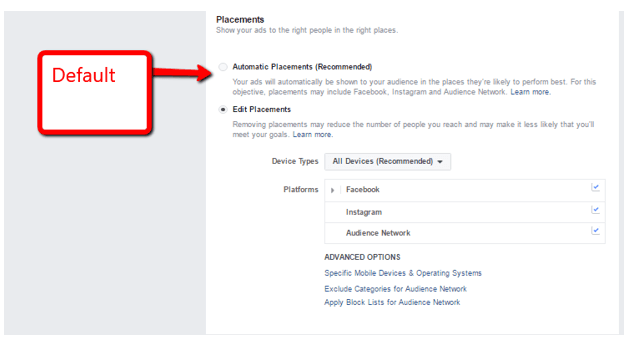
Did you know only the first option is for advertising within Facebook? Second option shows your ads in Facebook’s subsidiary, Instagram, and for the third option, you don’t even know where your ads are displayed!
You may think it’s harmless, but Instagram burns your money faster than fire spreads in the forest (Instagram is hardly profitable for most businesses). If you do not have a big budget to invest for ‘brand awareness’, do scrutinise your settings before clicking ‘confirm’, or you may just fall into one of these traps.
3. Watch out for foreign likes
Let’s say you checked your targeting settings hundred times and have made sure that you are targeting high net worth individuals in Singapore. Your ads are still not getting any sales. You decided to click into the profile of people who like your ads. To the shock of your life, these are not locals! You got a lot of engagement with plenty unfamiliar-looking profiles instead.
Another trap of Facebook advertising is its ‘smart’ algorithmn. Facebook automatically optimises your ads to appear in front of people most likely to click or engage with ads. Coincidentally, these people may not be people who buy, but people who like to like your posts. More often than not, these are not the locals.
What can you do about it ?
Well, Facebook’s advertising platform is a powerful machine, as long as you know how to tap its potential. Make use of the ‘exclude’ feature to exclude audiences you do not want to target! You can exclude foreigners or other groups you know will never convert into a customer. In one of our campaign for a property company, we excluded all property agents in Singapore.

4. Avoid the shortcut
If you are wondering why the options above are not accessible in your computer, you probably have been boosting posts only.

Amazon and other e-commerce stores have their 1-click purchase to make it easy for people to buy. Facebook came out with their own version of this with the ‘1-click advertise’ option, which is the boost post button.
It saves time and hassle at the expense of cutting out a lot of features you would see in ads manager and power editor. To encourage its use, Facebook repeatedly reminds you with messages like this:

Many advertisers have likened clicking boost-post to writing a blank cheque to Facebook. If you don’t have deep pockets, avoid the trap of the shortcut and instead go deeper into what Facebook offers.
Facebook’s share price has been on the rise as more and more businesses jump on the advertising bandwagon. Without proper know-how, businesses owners are just contributing to the bottom line of Facebook. On the other hand, with the right strategy, you can be among those succeeding.
5. It’s not traditional one-way advertising
The power of Facebook lies in its social potential. It can go both ways. You ads has the chance of going viral. However, it can also backfire.
Check out this ad by OCBC bank:
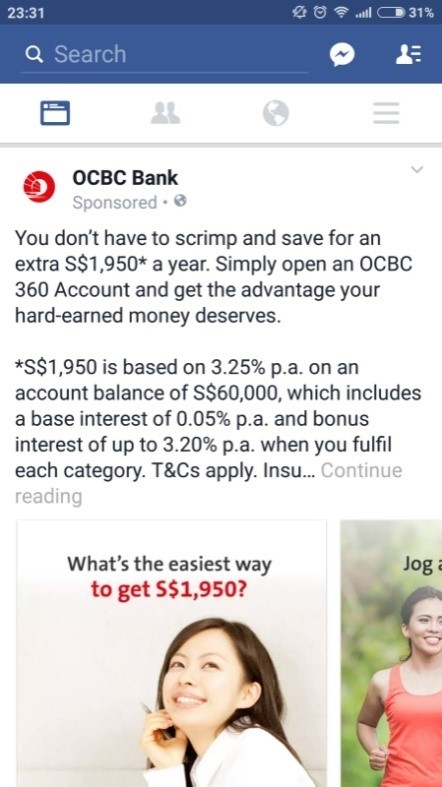
It looks like any normal and decent Facebook ad, until you scroll down further to the comments section. Did you realize that they are paying money to advertise for their competitor ? Guess what, after seeing this ad, I took action and shifted my money to BOC. You can say its pretty ‘successful’.
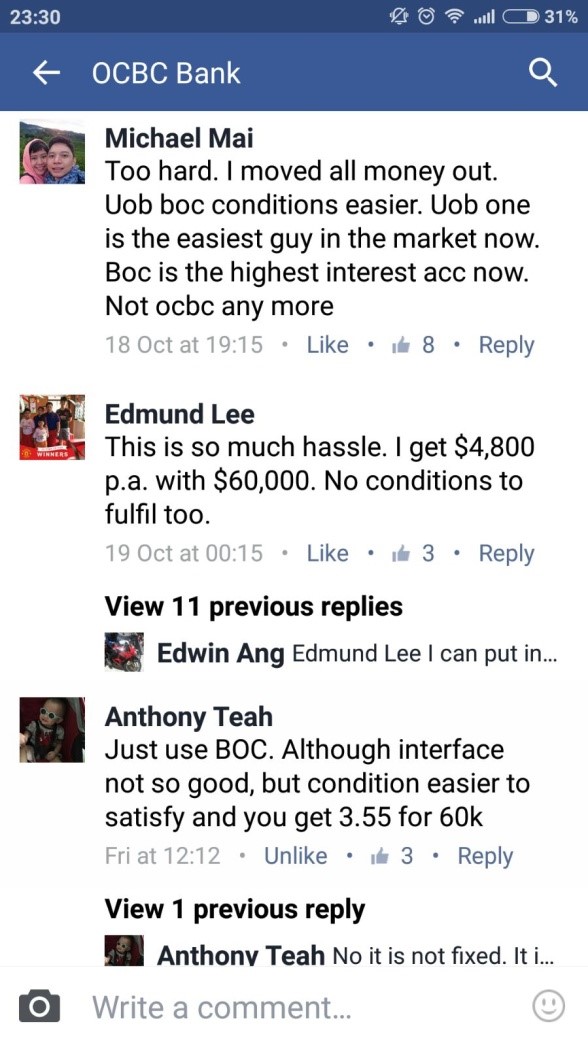
Many traditional advertisers fall into the trap of approaching Facebook advertising the way they do for newspaper or magazine advertisement: that is to publish and forget. The wonder of Facebook is that it produces a lot of feedback for you to fine tune your ads over time. Make use of these quantitative and qualitative feedback to improve on your performance.
6. Be a data geek
Speaking of getting quantitative feedback …
Since Google, Facebook and other digital advertising platforms came into the picture, marketing has largely evolved into more of a geeky sports. The amount of data available for decision making is tremendous. Your left brain muscles matter as much, if not more than your right brain muscles today.
Fret not, you don’t need to start hiring a data scientist. To make it simple, important metrics to look at include your cost per click, clickthrough rate and conversion (most businesses are not measuring!).
So, what is considered decent numbers? According to Nanigans, a data company, the average clickthrough rate in Asia in 2016 is 1.97 per cent. If you are doing less than 1 per cent clickthrough, you are paying a lot more money than you should.
In our own example, we were collecting emails on Facebook with a free ebook. I changed the ad image from the 1st to the 2nd and saw an increase in clickthrough and leads conversion by 50 per cent!
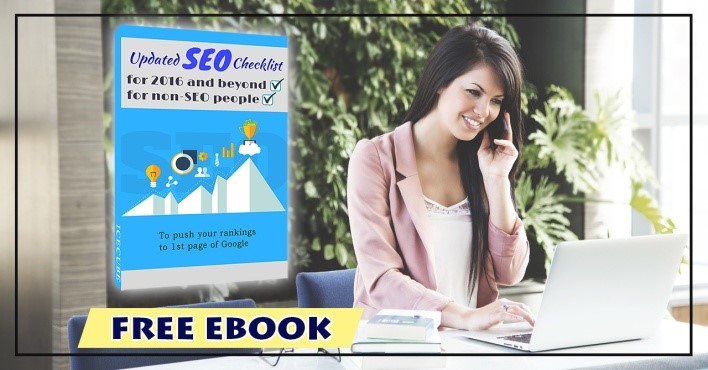
First ad image
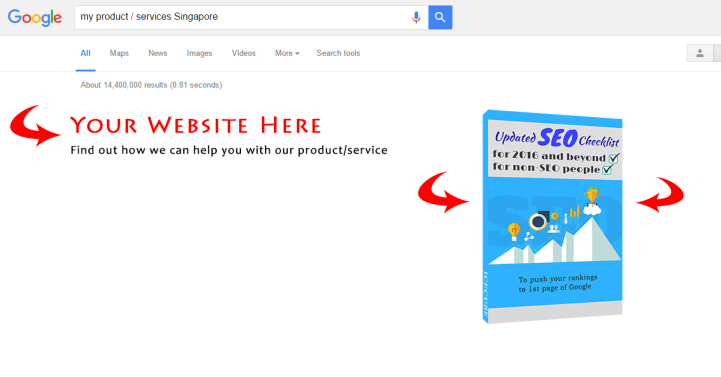
Second image with 50% higher clickthrough and conversion
This would not have been possible if I were to advertise in say, newspaper where I get only one shot at success. Today, the data available for fine tuning our ads provides unprecedented opportunity. It makes leads generation a highly predictable and consistent process, almost to the point of being scientific.
Stability: Isn’t that what we all want ?
7. Go for softer conversions
Facebook likes to keep users within Facebook. That’s obvious: No media publisher wants to send people away. Thats why they introduced new features such as Canvas ads, as well as instant articles to confine people within their ecosystem. As an advertiser, this is not to your advantage. Facebook is the land of shiny objects where a thousand and one things demand the attention of your prospects.
Think cat videos, ex-girlfriend’s pictures, etc. As an advertiser, instead of trying to sell your product on Facebook where attention span is almost nonexistent, strive to get them to click into your website or landing page and opt in to an offer that doesn’t take a lot of brain power to process. Don’t be overly ambitious in getting them buy on the spot. Use soft conversions.

Facebook distraction
Conclusion
At the end of the day, don’t stop trying. Getting burnt in Facebook once doesn’t make it a useless platform. After all, isn’t it the spirit of entrepreneurship to keep trying?
Having taken the time to educate yourself on the 7 traps above, you are better equipped to deal with Facebook than ever before. Like all other aspects of your business, once you find the right formula, Facebook will help skyrocket your sales. Importantly, it provides the consistency and stability of business that all of us need.
Don’t miss out on this awesome opportunity! Facebook ads is going to get more expensive over time. The best time to jumpstart your engine is now.
—-
The views expressed here are of the author’s, and e27 may not necessarily subscribe to them. e27 invites members from Asia’s tech industry and startup community to share their honest opinions and expert knowledge with our readers. If you are interested in sharing your point of view, submit your post here.
Featured Image Copyright: alaskla / 123RF Stock Photo
The post Don’t fall victim to the 7 traps of Facebook marketing appeared first on e27.
